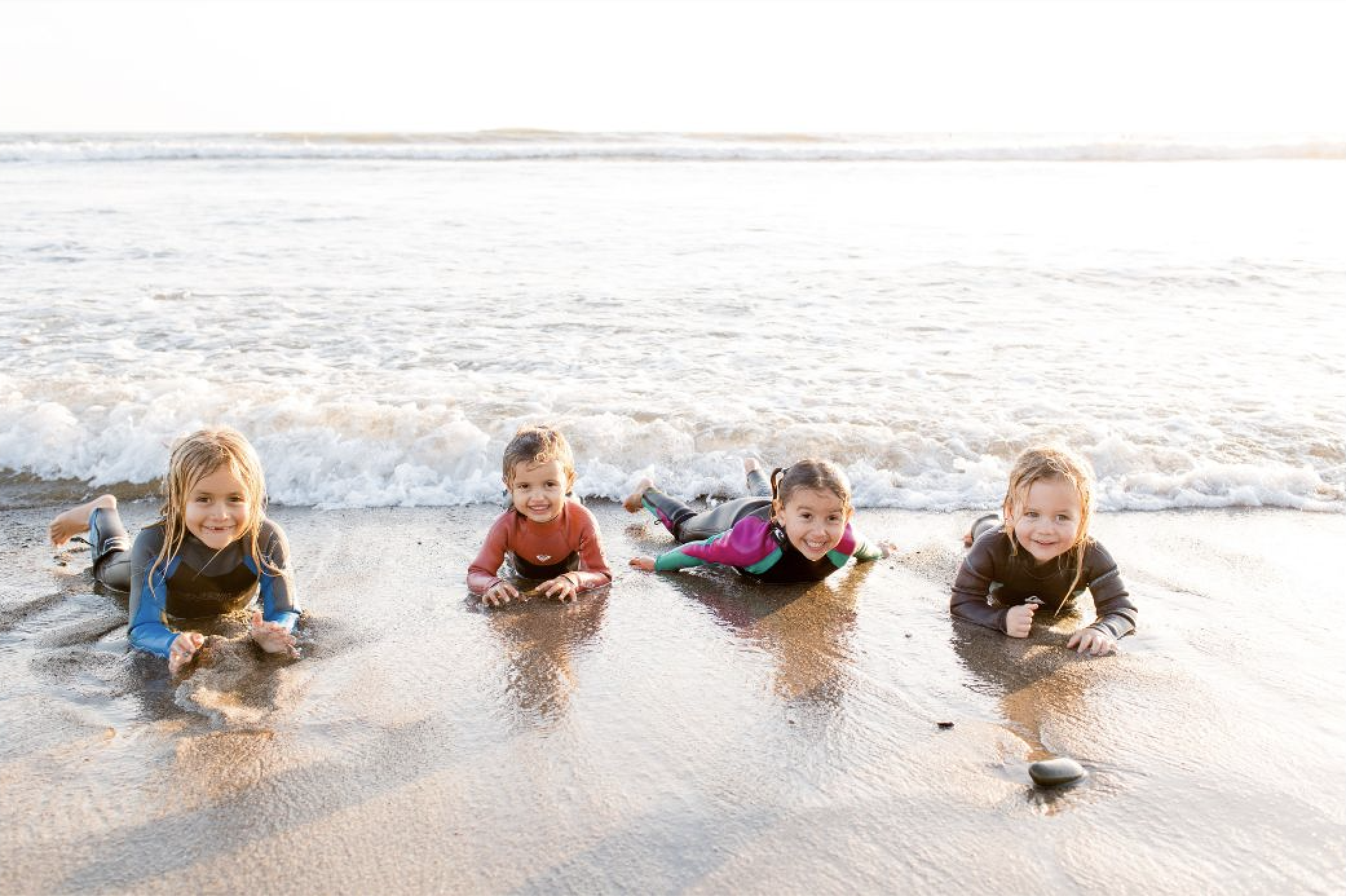
We tested the best kids’ wetsuits in the game from O’Neill, Roxy, Quiksilver, and others. Photo: Camryn Clair
Wetsuit technology has come a long way. There are seemingly endless options of adult wetsuits nowadays, but finding a good wetsuit for my little ones proved more challenging than I expected. Even with limited options, I found navigating the choices of kids’ wetsuits more challenging than finding a wetsuit for myself because of the lack of good reviews and detailed information out there. So, we asked the top wetsuit makers to send us their best kids’ suits, and we put them to the test surfing and playing at San Onofre, during one of southern California’s coldest winters.
Read on for our top picks and scroll to the bottom for info on how we tested, what criteria we used, and what you should know before buying a wetsuit for your kid. While there are differentiating features amongst these suits, I found the differences between most of them to be rather slim. Everyone has different preferences in what they are looking for, so I hope the comparison chart we included below helps you determine which suit is best for your kids.
The Best Kids’ Wetsuits
Best Overall Kids’ Wetsuit: Buell Stealth Mode 4/3mm ($190)
Easiest Kids’ Wetsuit to Get On/Off: Quiksilver Boys Prologue 4/3mm ($99) &
Roxy Girls Prologue 4/3mm ($95)
Most Flexible/Comfortable Kids’ Wetsuit: O’Neill Epic Boys 4/3mm ($199) &
Girls 4/3mm ($199)
Most Sustainable Kids’ Wetsuit: Patagonia R2 Yulex ($219)
Honorable Mention: Rip Curl Omega Grom 4/3mm ($145)
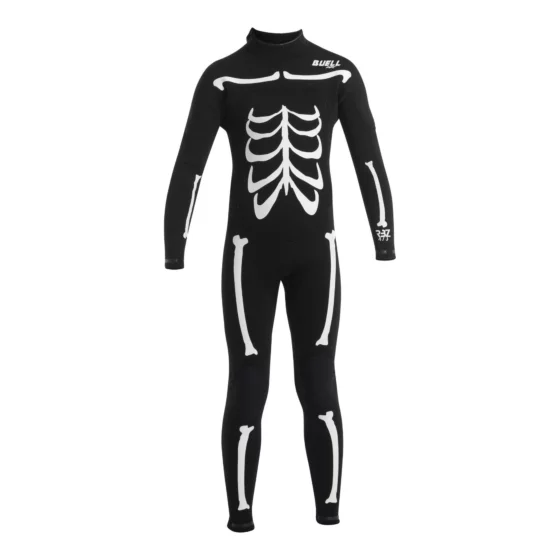
Best Overall Kids’ Wetsuit
Buell RBZ Stealth Mode 4/3mm ($190)
Available In: Sizes 1-5
Warmth: 10
Ease of Getting On/Off: 8
Comfort and Flexibility: 8
Durability: 9
Overall: 9.2
Sustainability: No
Features: Flexible ninja neoprene, soft interior lining, interior seam tape throughout, leg zippers for easy entry, and an extra layer of material on the back to reduce water entry at the zipper.
The kids Buell RBZ Stealth Mode has all the features we look for in a good kids’ wetsuit. This suit is made from a warm but stretchy 4/3 mm material and has a soft interior lining throughout, solid seam construction with interior tape, and easy entry with a back zip and leg zippers. Another feature that makes this suit stand out is that it was the only back zip suit that had an extra layer of material on the inside back to prevent water entry through the zipper – this makes the suit slightly harder to get on and off but it’s still way easier than a front zip. This suit comes in a few different colors, including Buell’s popular skeleton design, which might be a no-go for some, but I found it to be cute on the kids and makes the suit fun for them as well.
Another thing I like about this wetsuit is that they make it for really little kids, starting at size 1. The only negative is that it isn’t sustainably made, and the skeleton design may be discontinued, so shop now for the best selection!
Check Price on Cleanline Surf Check Price on Cleanline Surf (Skeleton Design) Check Price on Amazon (Skeleton Design)
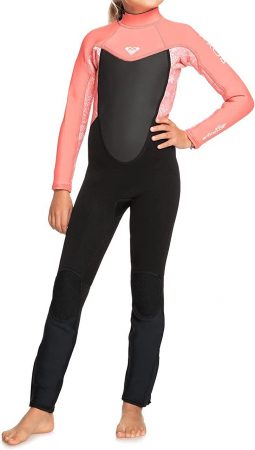
Easiest Wetsuit to Get On/Off
Quiksilver Boys Prologue 4/3mm ($99) &
Roxy Girls Prologue 4/3mm ($95)
Available In: Sizes 2-14
Warmth: 8.5
Ease of Getting On/Off: 10
Comfort and Flexibility: 7
Durability: 7
Overall: 8.4
Sustainability: AQUA GLUE eco-friendly lamination.
Features: Warmer smoothie rubber on the chest panel, quality GBS seams, leg zippers for easy entry.
Quiksilver and Roxy have nailed it when it comes to making functional kids’ suits that are easy for parents to get their little ones in and out of. This is the suit we had for our girls before starting this article and it’s a great suit. It’s not the stretchiest material and there’s no interior lining, but it does the trick and keeps our little ones warm and happy for hours. They are super easy to get on and off with a back-zipper entry and extra leg zippers, making pulling them off after a chilly session a breeze. The only difference I noticed between the Quiksilver Prologue and the Roxy Prologue was the color.
Check Price on Evo
Check Girls Price on Amazon Check Girls 3/2mm Price on Amazon
Check Boys Price on Evo
Check Boys Price on Amazon (Size 8-16) Check Boys 3/2 Price on Amazon
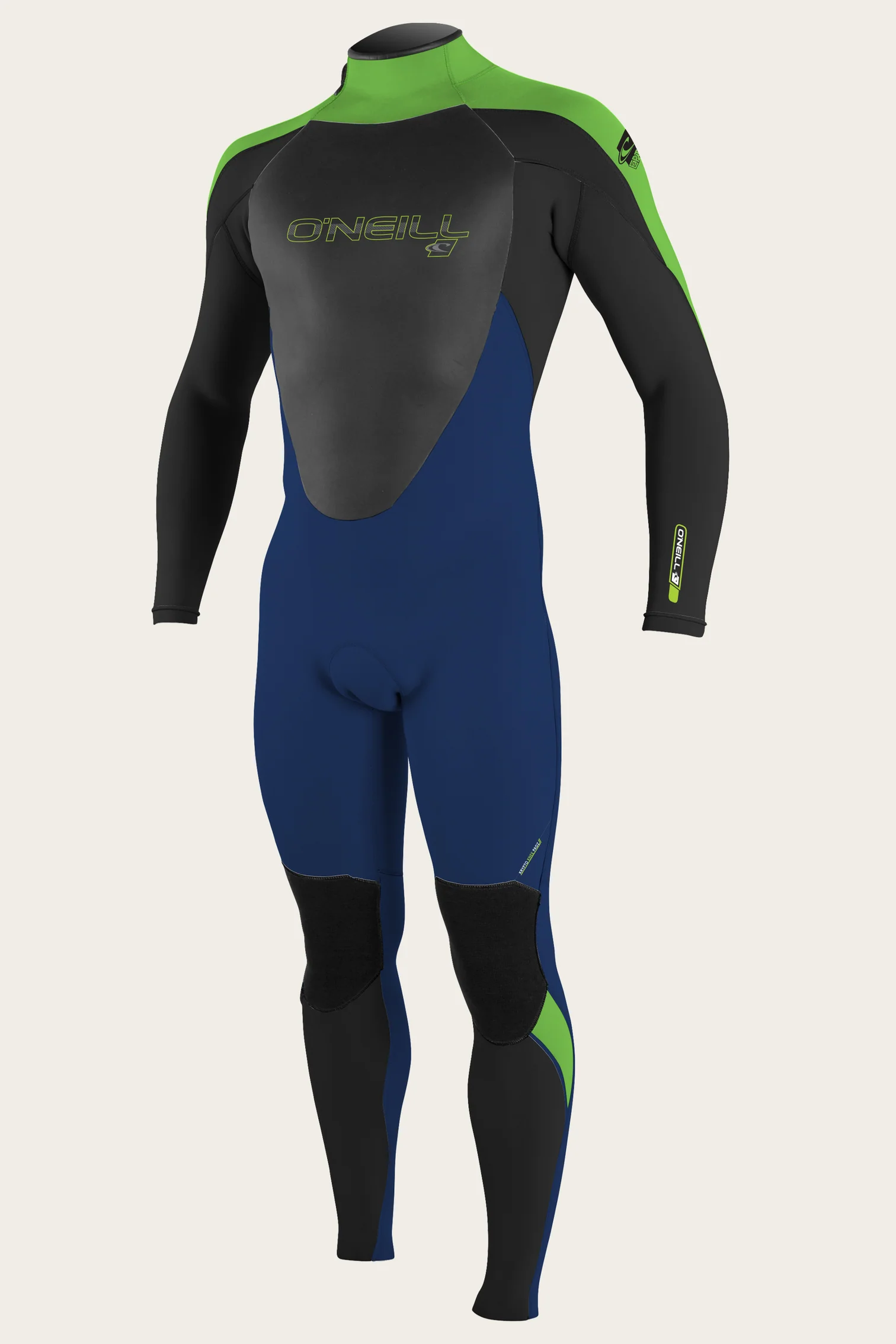
Most Comfortable/Flexible Kids Wetsuit
O’Neill Epic Boys 4/3mm ($199) & Girls 4/3mm ($199)
Available In: Sizes 4-16.
Warmth: 8.5
Ease of Getting On/Off: 9
Comfort and Flexibility: 9
Durability: 7
Overall: 8.6
Sustainability: No
Features: GBS seams, soft interior lining in the chest area
According to our four-year-old, this suit is “comfy cozy.” Everything from the seam placement, soft interior chest lining and stretchiness of the fabric contribute to the superior comfort of this suit. This suit is also relatively easy to get on and off with the back-zipper entry. However, it does not have leg zippers like the Buell, Quiksilver, and Roxy. The absence of leg zippers didn’t make a noticeable difference in getting the suit, but it was slightly harder to pull off.
If you have kids that are doing a lot of paddling on their own, this might be a good option as the seam placement and stretch of the shoulder area allow for more mobility than some of the other options. One thing to note is that this suit doesn’t start until size 4, which is still slightly big on our four-and-a-half-year-old. If you need a suit for a child younger that four, you’ll need to go with another option.
Check Girls Price on Cleanline Surf Check Girls Price on Amazon
Check Boys Price on Cleanline Surf Check Boys Price on Amazon
Check 3/2mm Price on Cleanline Surf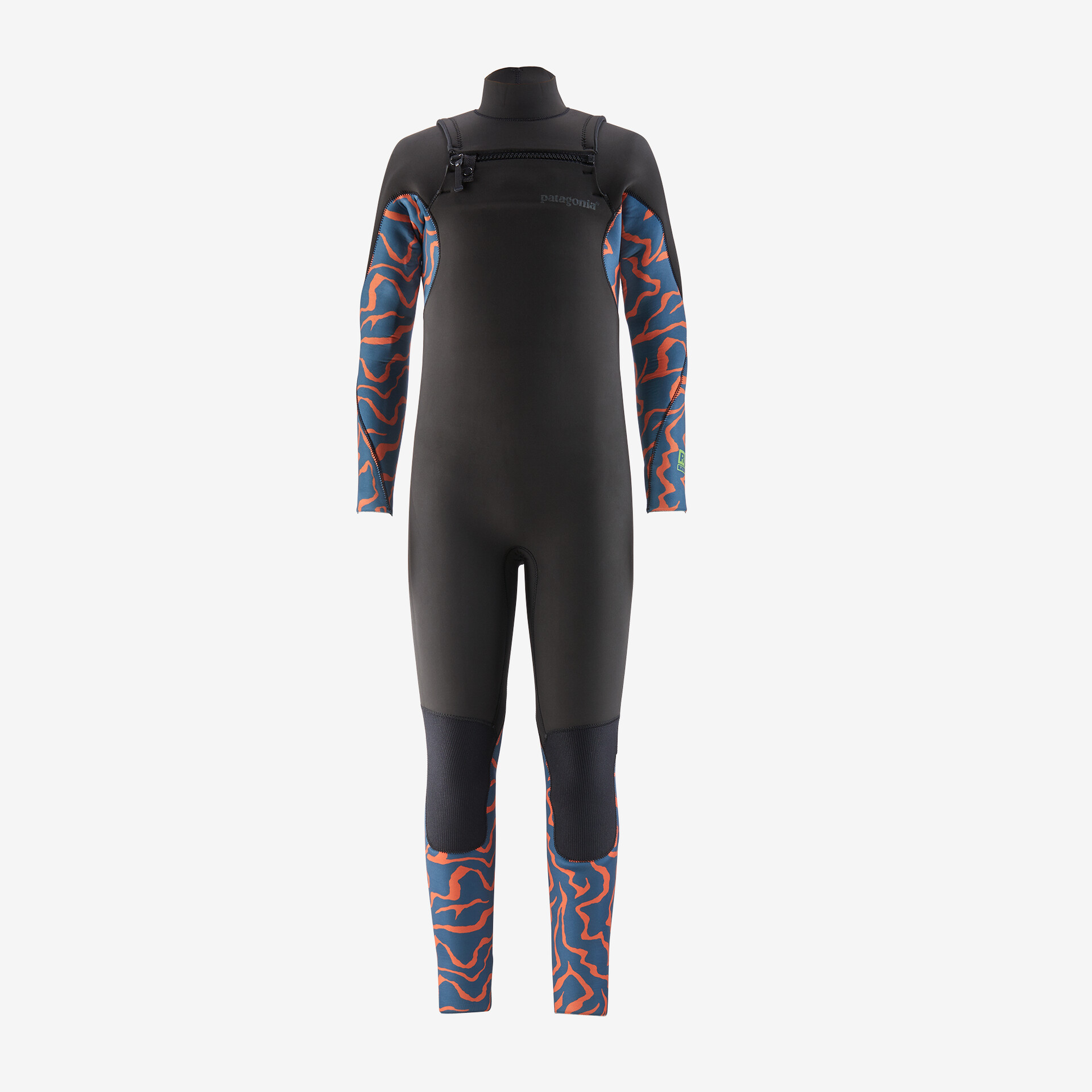
Most Sustainable Kids’ Wetsuit
Patagonia R2 Yulex ($219)
Available In: Sizes 6-16
Warmth: 9.5
Ease of Getting On/Off: 6
Comfort and Flexibility: 7
Durability: 9
Overall: 8.3
Sustainability: Yulex rubber, recycled lining, fair trade and sustainable manufacturing.
Features: Warm interior lining and taped seams throughout.
Patagonia wetsuits are the most sustainable wetsuits you can find, period. Made from all-natural Yulex material, their impact on the environment is minimal. Also of note is the brand’s repair policy, where they’ll do all they can to keep your suit seaworthy for as long as possible.
This was the only front-zip entry wetsuit we tested, which many prefer for adult suits, but I am not a fan of for kids’ suits as it is challenging to get them on and off. Features we did enjoy were the thermal lining made from recycled materials and taped seams, for added warmth and durability. The R2 wetsuit is a bit thinner than your classic 4/3 mm at 3.5/3 mm, but the kids that tested it thought this was one of the warmest suits we tested. The suit is a little stiffer than some other options, but we found that it loosens up with wear. One thing to note is that this suit doesn’t start until size 6, meaning it’s not an option for smaller kids. Also, the sizing runs big. Of all the size 6 suits we got, this suit was at least three inches longer than the next largest.
Check Price on Patagonia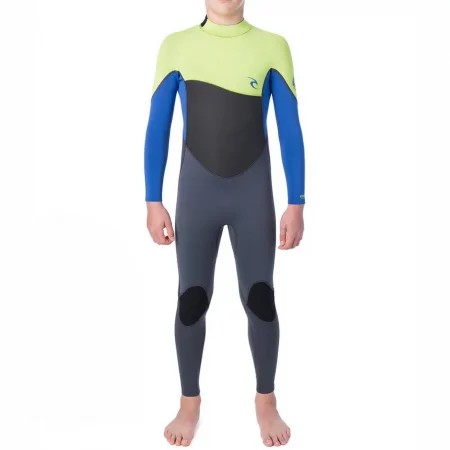
Honorable Mention
Rip Curl Grom Omega 4/3mm ($145)
Available In: Sizes 0-8
If you are looking for a warm wetsuit for a kid under two, the options are extremely limited. The only brands that we could find that make 4/3 mm wetsuits in sizes under two are Buell and Rip Curl. We already mentioned the Buell Stealth Mode above, which starts at size 1. The Rip Curl Grom Omega is the only 4/3 mm wetsuit on the market that starts at size 0. While we did not test this suit, Rip is a company known for quality, and I would recommend this suit if you are looking for a high-quality suit to keep a kid under two years old warm. I wish I had found this suit when my little ones were that small. We used suits that were too big, which limited their water time.
Check Price on Cleanline Surf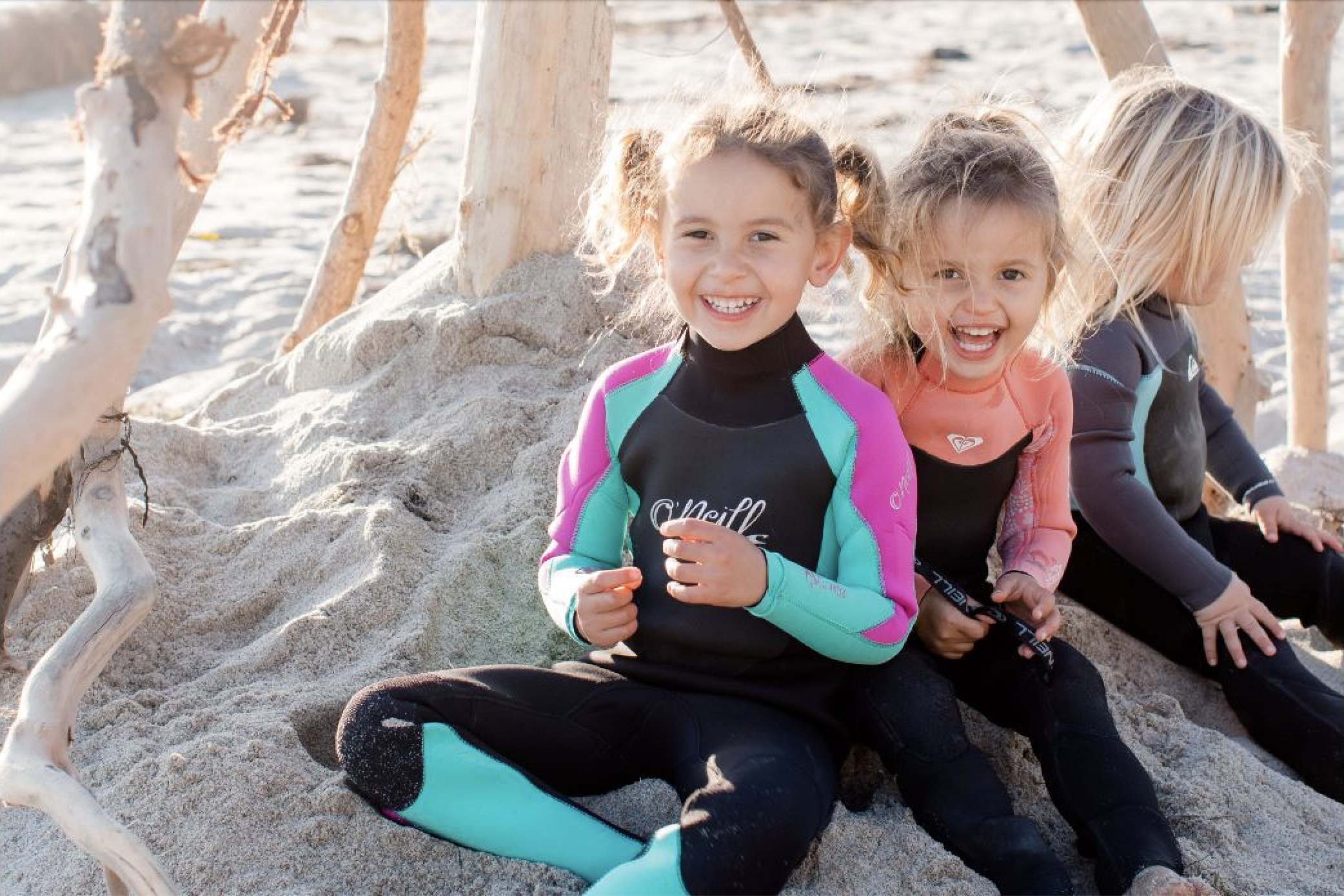
All smiles thanks to O’Neill and Roxy. Photo: Camryn Clair
Brands We Did Not Test
While we did not get suits to test from the following wetsuit brands, we were curious about their offerings and below are the notes from our research.
Billabong
They have several good kids suits starting at size 6, but no 4/3mm suits under size 6. They offer one fullsuit in sizes 2 to 6, the Boys Absolute Back Zip 3/2mm. While this suit is made with eco-conscious fabric, it is a thinner suit and only comes with flatlock stitched seams, so I wouldn’t recommend it if you are looking to keep your kids warm.
Xcel
They have the easiest website to navigate wetsuit options for kids (and adults) and they have two kids’ suit options that start in size 1, the Toddler 3 mm and the Toddler Water Inspired 3 mm. Similar to Billabong, both only come with flatlock stitched seams, so they aren’t the best for keeping your little ones warm. Starting at size 4, they offer the Kids Axis Back Zip 4/3mm, which I bet could compete with the suits we tested in terms of warmth, comfort, and durability. This suit also comes in multiple color combinations, so kids can pick the style they like.
Sisstrevolution
I was impressed with the selection of kids suits offered by Sisstrevolution. Unlike most brands who have one or maybe two fullsuit options in smaller sizes, the majority of their youth suits start at size 2, so you have lots of options to choose from. While we have never tried their kids’ suits, I met a family at the beach who had a seven and five year old who both wear the 7 Seas 4/3 mm Front Zip suit. While I personally wouldn’t recommend the front zip for small kids, they also offer a 7 Seas 4/3 mm Back Zip that I would be keen to test. Their suits also come in a variety of colors, which is an added plus for the little ones.
Vissla
We couldn’t find any kids wetsuits under size 8.
Feral
It appears they only offer adult wetsuits at this time.
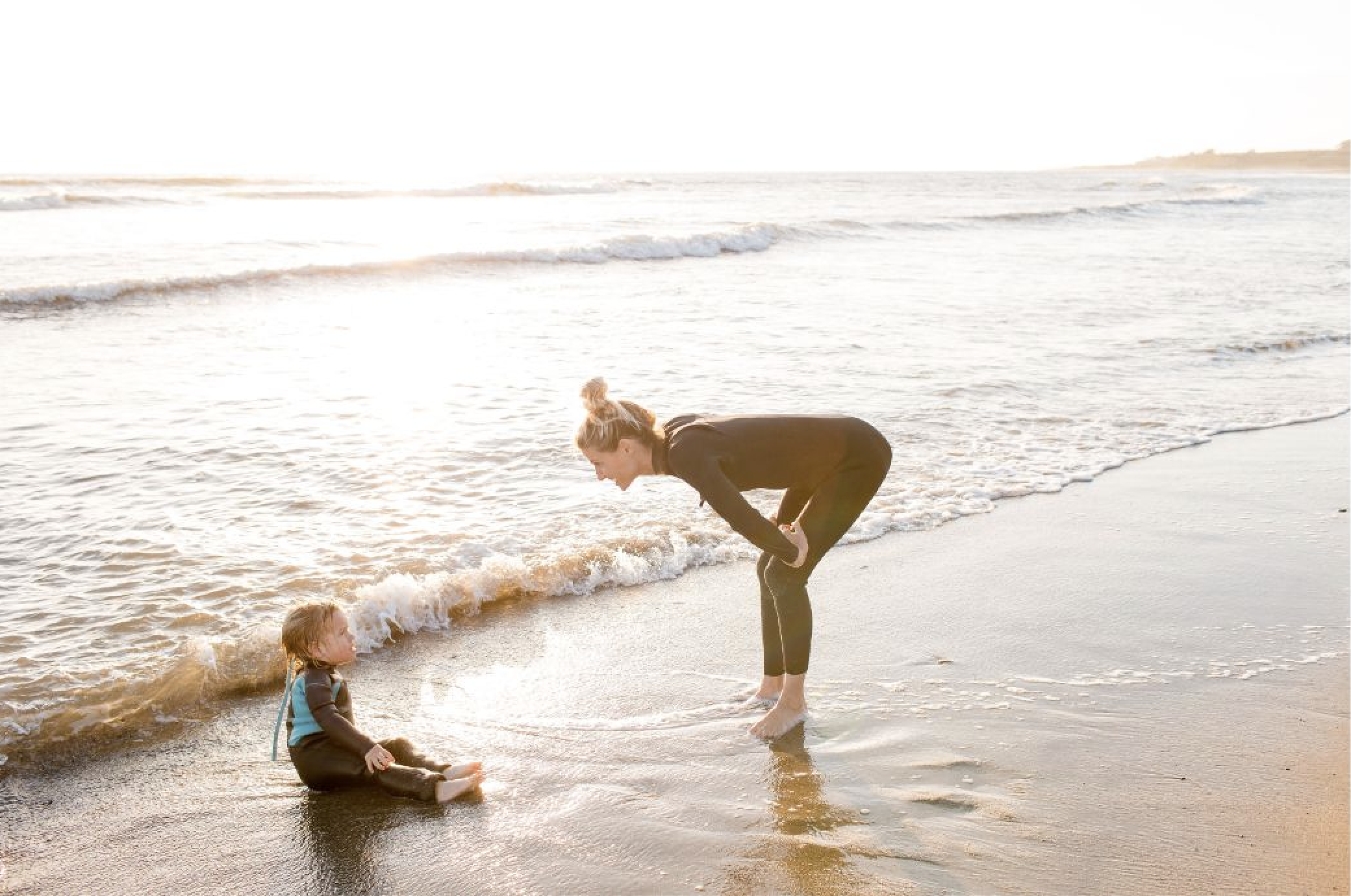
Photo: Camryn Clair
How Did We Calculate Recommendations for Best Kids Wetsuits?
Like our recent adult wetsuit review articles (Best Men’s Wetsuits and Best Women’s Wetsuit), we looked at warmth, comfort/flexibility, and durability. When considering the factors that make a good kids’ wetsuit, we also thought it was important to evaluate the suits on their ease of getting on and off since parents often will be helping with this. Each suit received a score out of 10 for each category, which we then averaged to reach the overall score. Since durability is difficult to determine after only a couple months of testing, that score was weighted less than the other criteria. Also, since kids have less muscle and body fat than adults and can get cold quickly, we decided to weight the warmth category more heavily.
Here’s the breakdown. Warmth: 50, Ease of Getting On/Off: 20, Comfort: 20, Durability: 10. In addition to these four criteria, we also noted whether the wetsuit was sustainably made as well as any noteworthy features. We chose not to evaluate the suits on style/fashion as that is a personal preference. Read on for a more detailed breakdown of these criteria, sustainability, and other things to know when looking to buy a kids’ wetsuit.
| Suit | Overall Rating | Price | Sizes | Sustainability | Closure | Leg Zip |
| Buell Stealth Mode 4/3 mm | 9.2 | $160 | 1-5 | No | Back Zip | Yes |
| Quiksilver Boys Prologue 4/3 mm | 8.4 | $99 | 8-14 | AQUA GLUE eco-friendly lamination | Back Zip | Yes |
| Roxy Girls Prologue 4/3 mm | 8.4 | $95 | 2-8 | AQUA GLUE eco-friendly lamination | Back Zip | Yes |
| O’Neill Epic Boys 4/3 mm | 8.6 | $199 | 8-16 | No | Back Zip | No |
| O’Neill Epic Girls 4/3 mm | 8.6 | $199 | 4-16 | No | Back Zip | No |
| Patagonia R2 Yulex | 8.3 | $219 | 6-14 | Yulex rubber, recycled lining, fair trade, & sustainable manufacturing | Front Zip | No |
| Rip Curl Omega Grom 4/3 mm | N/A | $145 | 8-16 | No | Back Zip | Yes |
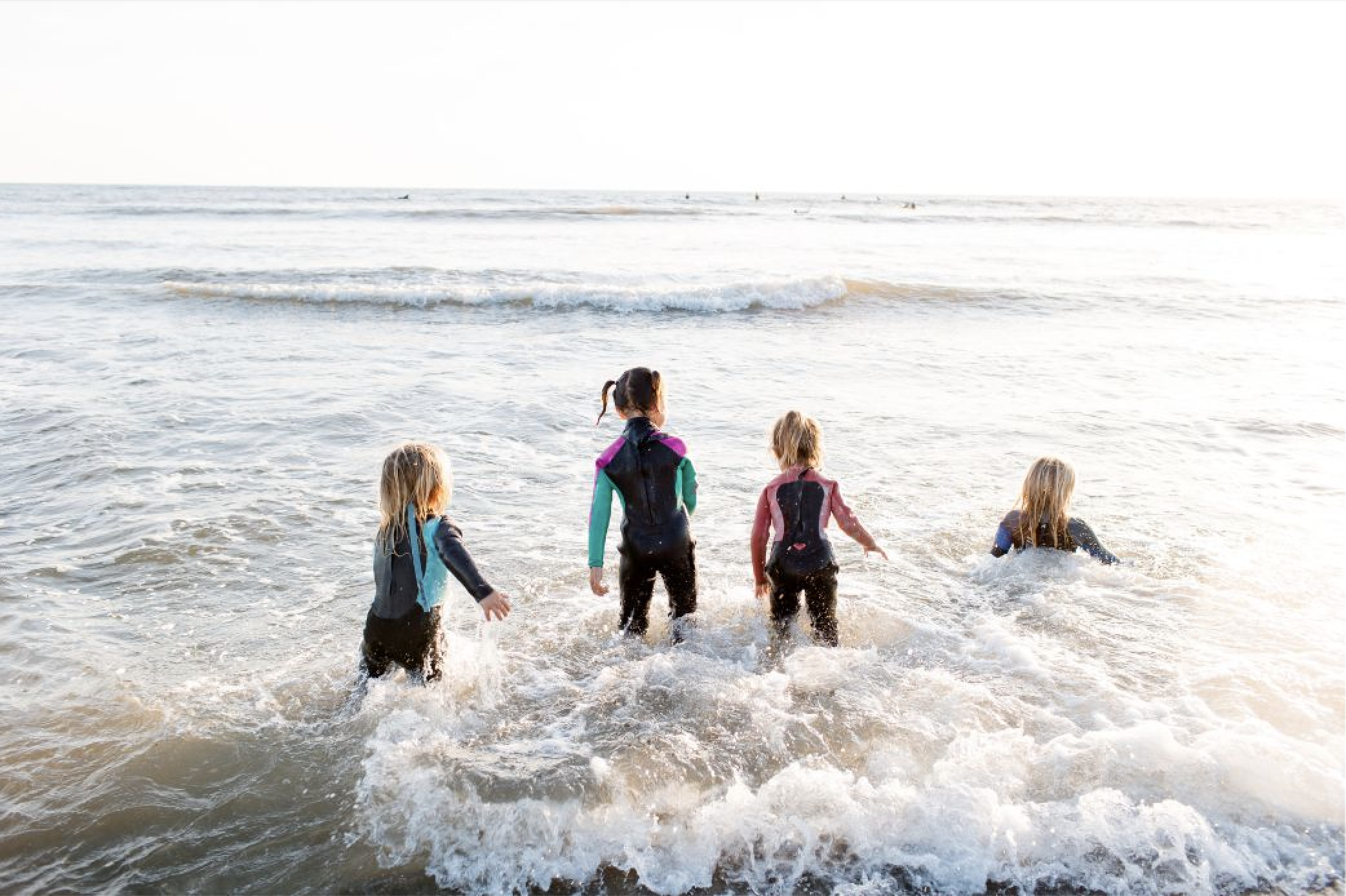
The groms, putting their suits to the test. Photo: Camryn Clair
How We Tested
The suits were tested by numerous San Onofre groms, ranging in age from two to seven. Most of the testing was done by my kids (ages three and four) who have loved swimming and surfing with mom and dad since birth. We put the suits through the wringer, testing them surfing, paddling, swimming, tubing, knee skiing, and rough playing on the beach. Most of this testing occurred at San Onofre during the winter with water temps ranging from mid-50s to low-60s and air temps ranging from 50-70 degrees.
Additionally, here is a bit about me since this article is ultimately my opinion of these suits based on their features and input from young kids.
I grew up Carlsbad, California and participated in most water sports and activities from a young age (including junior lifeguards, surfing, bodysurfing, swimming, skiing, wakeboarding, and playing water polo). I could swim before I could walk and I could ski before I could ride a bike. I played water polo in college at Stanford University and lived in San Francisco for a few years after college, getting to know the colder NorCal breaks, before moving back to southern California and settling in San Clemente where I’ve been for the last 15 years. Nowadays, myself, my husband, and our two kids can often be found longboarding at San Onofre, often with a kid on our board, riding our mid-lengths at Church or Middles, or bodysurfing San Clemente’s shore breaks. It’s safe to say I’ve had plenty of years of experience buying and evaluating wetsuits.
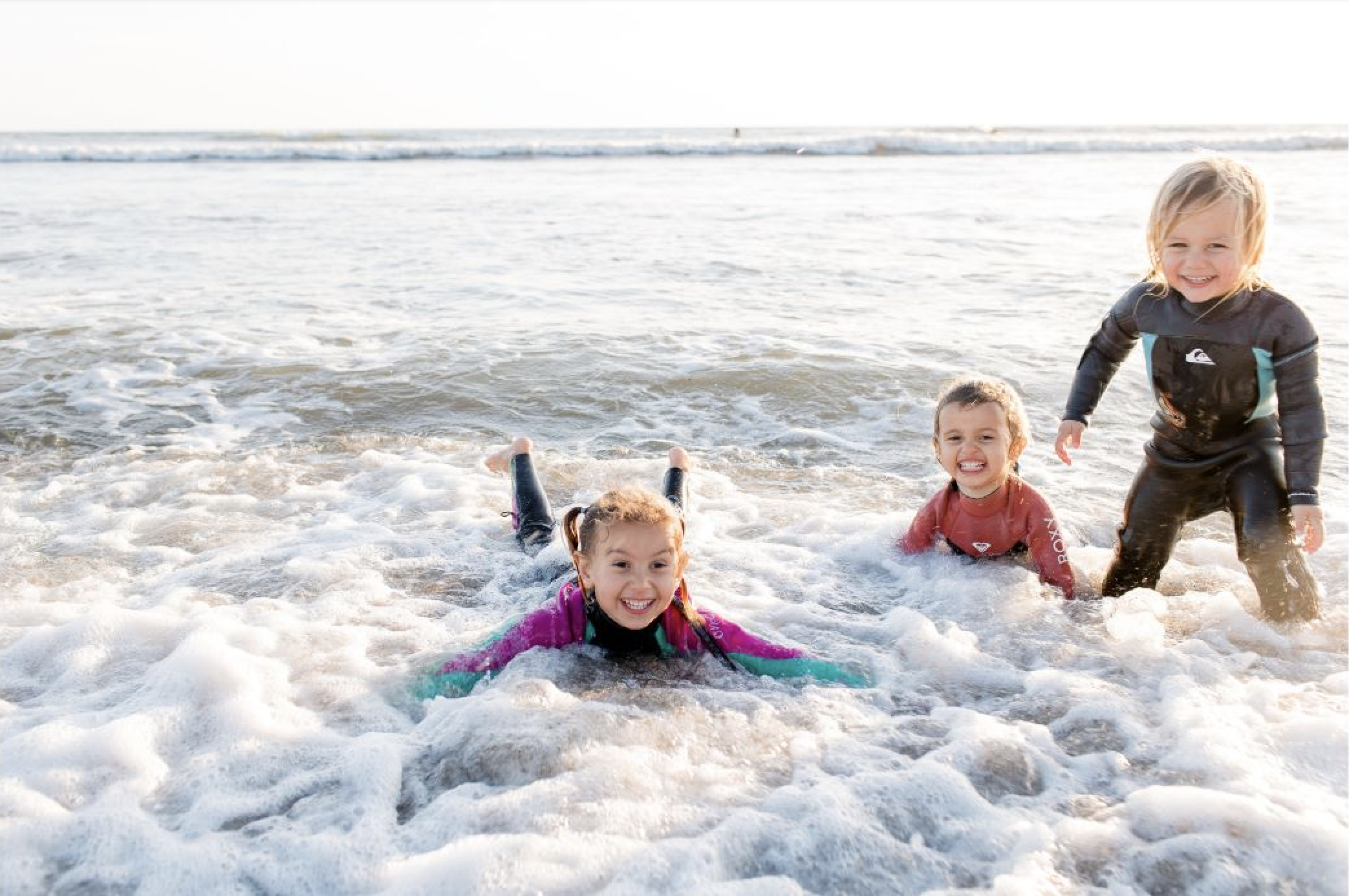
Photo: Camryn Clair
What Should You Know Before Buying a Kids’ Wetsuit?
Kids’ Wetsuit Sizes
Kids’ wetsuits sizes loosely correspond to age. For example, a size 4 wetsuit should be a decent fit for most four-year-olds. That said, we found quite a bit of variation on this front. For example, a kids’ size 6 Patagonia wetsuit is four inches longer than a kids size 6 O’Neill wetsuit. Therefore, we suggest always checking the sizing chart if you are buying online or preferably have your kid try on the wetsuit before buying it. When looking for a wetsuit, it is also helpful to know that kids’ wetsuits are usually divided into the following categories: youth or junior wetsuits for kids age 8-16, kid or grom wetsuits for kids ages 4-7, and toddler wetsuits for kids ages 0-3. All the top brands have a solid selection of youth suits (ages 8-16). Most of the top brands have kids suits (ages 4-7), although some start their offerings at size 6. There are very few brands that offer quality toddler suits. This article focuses on kids and toddler wetsuits or what to look for in a wetsuit for kids ages 0-7.
Wetsuit Fit
Fit is one of the most important factors when getting your kid a wetsuit. No matter how incredible the suit is, if it doesn’t fit your kid well, it’s not going to get the job done. In general, a wetsuit should fit your kid snuggly, but not be so tight that it is impossible to get on or restrict their range of motion. If the wetsuit is loose in the neck, wrists, or ankle areas, then water will rush in, defeating the purpose of the suit altogether. If the wetsuit is too tight, then they will not want to wear it. In terms of fit, there is no difference between boys and girls suits, as kids have the same body type until they reach puberty.
Types of Wetsuits
The two most common kids’ suits are springsuits and fullsuits. Springsuits have short legs and short arms. Fullsuits have long legs and arms that come to the ankles and wrists. This article focuses on fullsuits, because that is what our kids wear year-round in southern California. We recommend a fullsuit for kids that want to play for extended periods of time in water below 75 degrees. All the brands mentioned in this article also offer springsuits. Springsuits are great for pool swimming or tropical waters (anything from mid-70s to mid-80s). Once the water temp gets above 85 degrees, most kids are fine without a wetsuit. But, you might want to consider a long sleeve rash guard or swimsuit for sun protection.
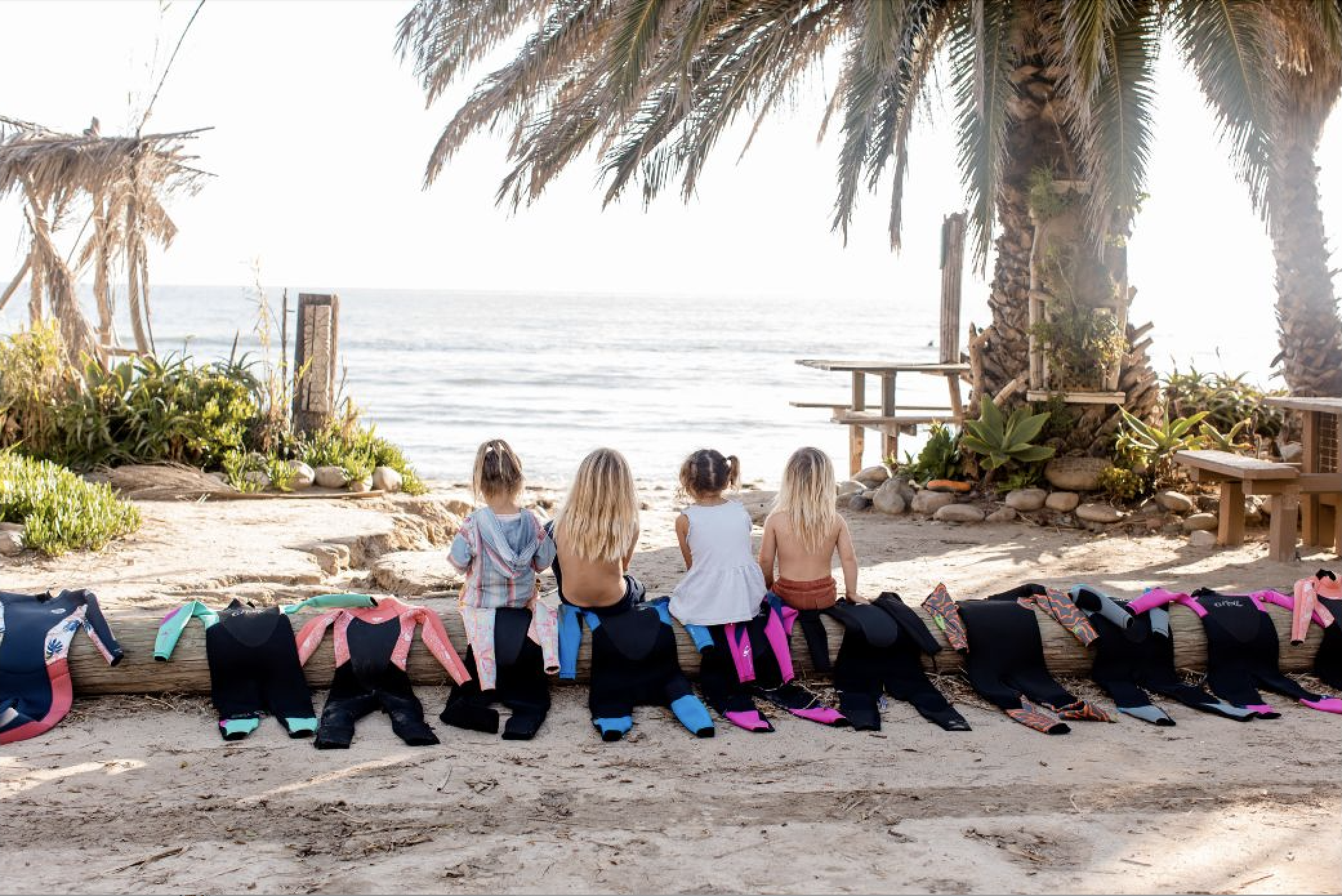
Photo: Camryn Clair
Wetsuit Thickness
Wetsuit thickness is measured in millimeters and varies from 1 mm to 6 mm. Most wetsuits use a thicker material for the core and chest area and a thinner, more flexible material for the arms and legs. For example, a 3/2 mm wetsuit is 3 mm in the chest/core area and 2 mm in the arms and legs. All the kids’ wetsuits we found ranged from 1 mm to 4/3 mm in thickness. The thicker the wetsuit, the warmer it is, but the less flexibility it provides. In southern California, our kids wear 4/3 mm wetsuits year-round. We could put them in 3/2 mm wetsuits during the peak of summer, but we prefer not to have multiple suits for them, and the added warmth increases the amount of time they can enjoy the water. Below is a general guide based on water temperature.
| Water Temperature | Kids’ Wetsuit Thickness |
| Water > 85°F | Rashguard only |
| Water 76°F to 85°F | 1 mm to 2/2 mm shorty |
| Water 70°F to 75°F | 3/2 mm full-length wetsuit |
| Water < 70°F | 4/3 mm full-length wetsuit & boots |
The above is a general guideline to abide by, but there are plenty of other factors to consider when choosing what thickness to get. Wind and sun are factors to consider. If it’s extra windy or not very sunny, it’ll make your kids feel colder, regardless of the water temp. Also, some wetsuits feature a “smoothie” panel on the chest area which can be helpful in blocking wind.
Entry System
Wetsuits come as either a front chest zip or a back zip. Front chest zip wetsuits generally allow for easier shoulder movement once on and can be slightly warmer as the neck seal is tighter, allowing less water entry. That said, front zip wetsuits can be challenging to get on and off. It is comically painful to watch a parent try to pull the chest piece over the head of a toddler, and I have never seen it go well. Then you have the challenge of getting it off when the kid is cold and wet. While I often wear a front zip while surfing and appreciate the benefits, it’s a hard pass for me regarding my kids and I don’t recommend a front zip for any kid under six.
Wetsuit Seams
Wetsuit seams are often overlooked, but they play a huge role in the overall warmth and durability of a wetsuit. The three main types of wetsuit seams are flatlock stitched, glued and blind stitched (GBS), and taped. A flatlock stitch is the cheapest option and offers the least amount of warmth. While flatlock stitching is durable, it lets water in through thousands of pinholes along the seams. Wetsuits with flatlock stitching often have less flex as well. Seams that are glued and blind stitched (GBS) offer more flex and warmth as the stitching doesn’t go all the way through the material, meaning no pin holes. In order to improve the durability of the wetsuit, one side is glued.
Wetsuits with GBS seams are not as durable as wetsuits with flatlock stitched seams, as they can fail along the seam. However, we haven’t experienced any seam failures in suits we’ve tested and have noticed this seam construction provides considerable added warmth. The third type of seam construction is taped seams, which is usually an extension of GBS seams. A layer of elastic tape is used to cover the glued and blind stitched seams (usually on the interior of the suit). This increases the durability and warmth of the wetsuit.
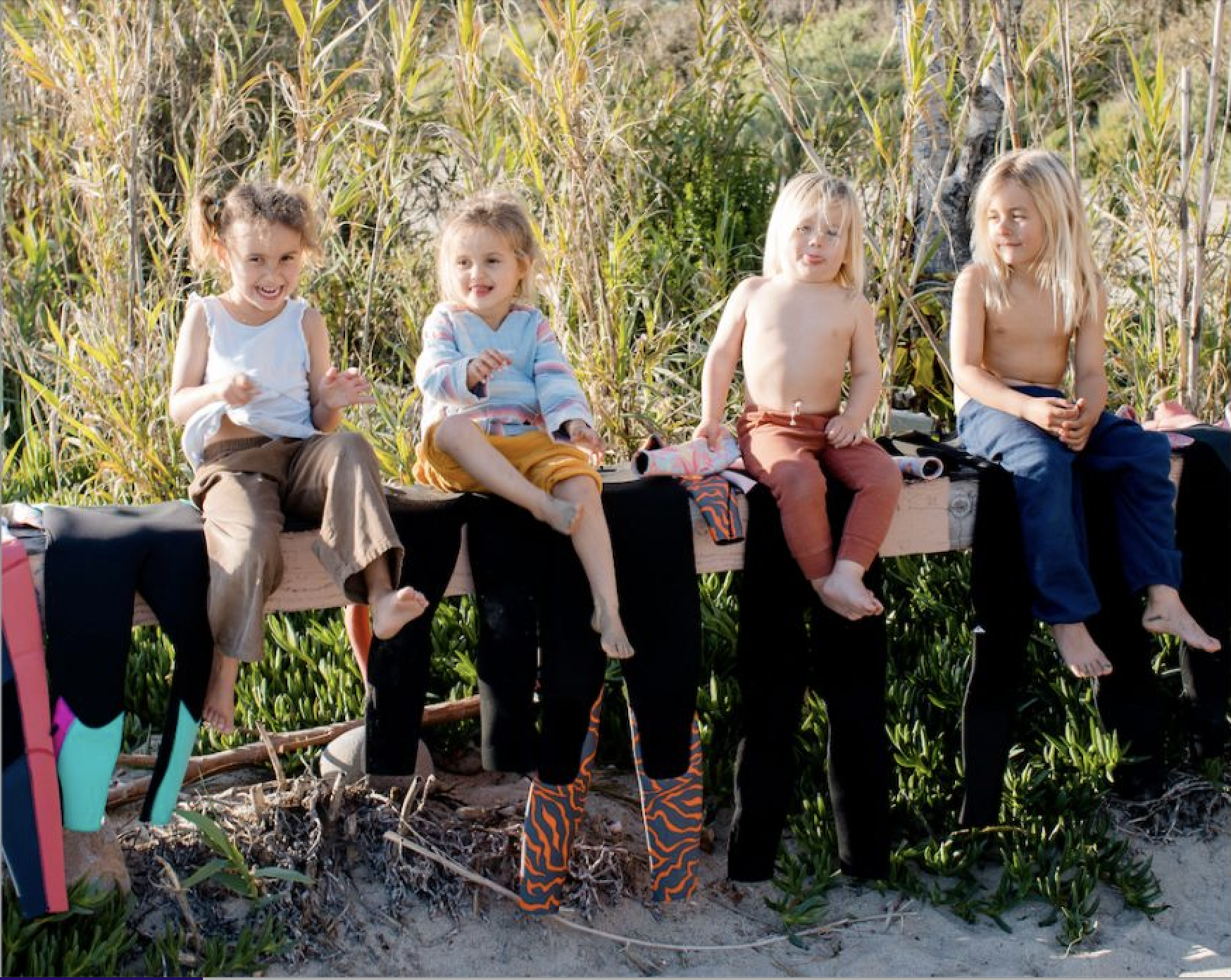
Photo: Camryn Clair
What Were Our Main Considerations When Purchasing Kids’ Wetsuits?
Warmth
As I shared above, kids have less muscle and fat than adults and can go from cold to hypothermic in a flash when swimming in cold water. Therefore, we first and foremost look for wetsuits that will keep our kids warm. There is a lot that goes into the overall warmth of a wetsuit, but most important to us is how well the suit fits, the material quality and thickness, and the watertightness of the seams.
Ease of Getting On/Off
Most kids need help getting their wetsuit on and off. Even with the help of an adult, some wetsuits are much easier than others to get on and off. The main difference we found is the front zip versus the back zip. For kids under six, we don’t recommend a front zip wetsuit. For additional ease, some brands have added leg zippers (from the ankle to halfway up the calf) in their kid and toddler lines. This makes it much easier and faster to pull the wetsuit off after a chilly session.
Durability
Since groms grow quickly, a wetsuit will likely only fit for a single season. Therefore, durability hasn’t been as important to us as some of the other considerations. That being said, we are big fans of hand-me-downs and always try to get at least two seasons out of our kids’ wetsuits (one for each kid). While material quality and seam construction contribute to the overall durability of a suit, we found that all the wetsuits we tested passed our durability test with little variation. We’ll update this article if that changes over time.
Flexibility
While wetsuit flex is extremely important for performance surfing, we found it much less important when selecting a kids’ wetsuit. Kids have endless amounts of energy and we generally found that if they are comfortable, the flexibility of the wetsuit isn’t an issue.
Style/Fashion
Kids love colors and fun designs. When we had the suits out to test, all the groms were quick to find the one they wanted with their favorite color or pattern. European kids’ wetsuit brand Saltskin has figured this out and makes kids’ wetsuits that look like wild animal costumes, which are quite popular on the other side of the Atlantic. Unfortunately, they can’t compete with the brands we tested in terms of warmth.
Sustainability
It used to be that if you wanted a sustainable wetsuit, your only option was Patagonia. While Patagonia’s Yulex material is still the most sustainable wetsuit material out there, a lot of other brands have followed suit and started making more sustainable adult wetsuit options. Unfortunately, there is still a long way to go in making kids’ suits more sustainable. I’d like to see more brands make kids’ suits from recycled materials like old tires and oyster shells, which is the next best material to Pategonia’s Yulex.
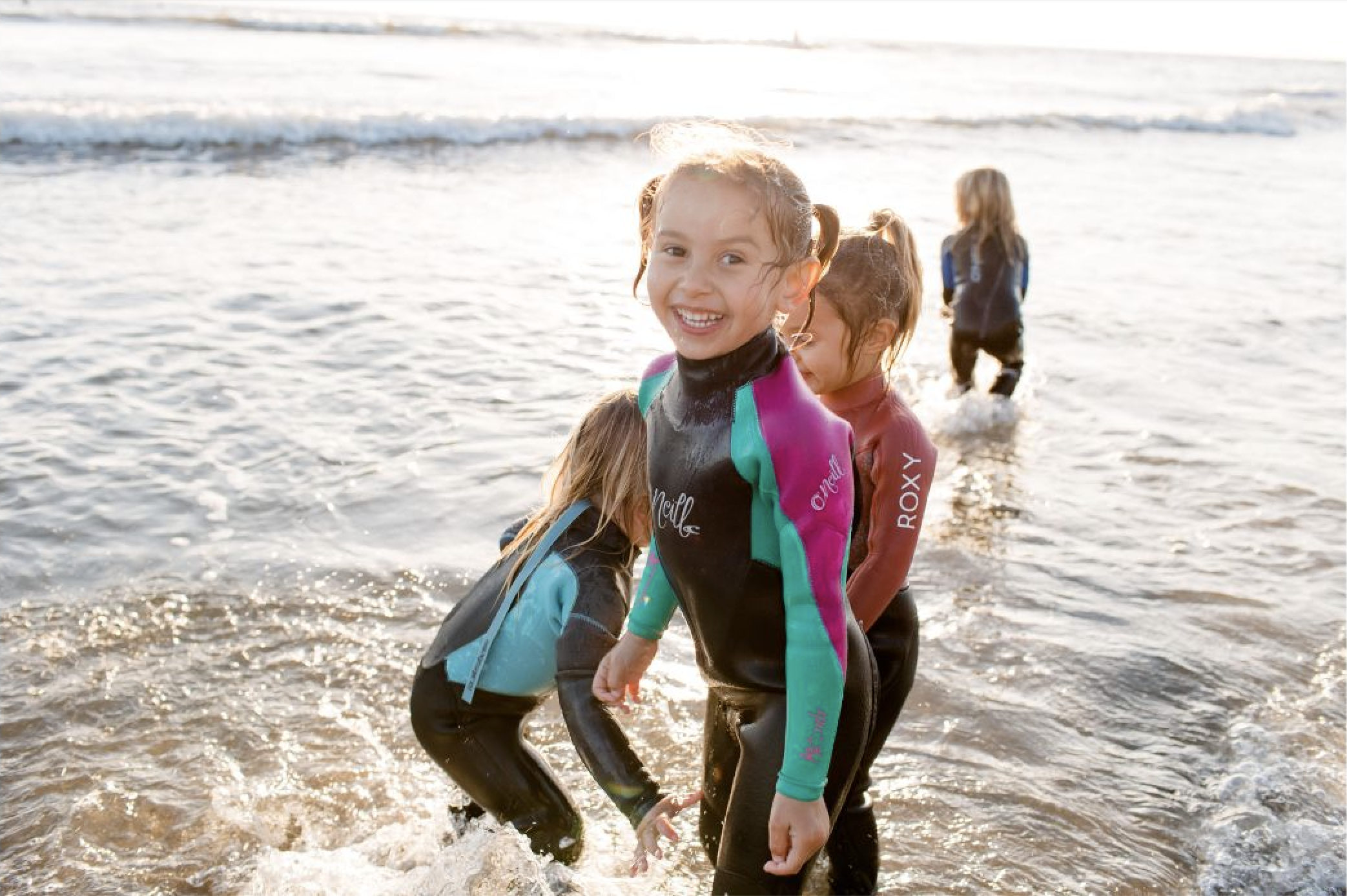
Photo: Camryn Clair
How Do I Take Care of My Kids’ Wetsuits?
Taking good care of your kids’ wetsuits ensures they have as long of a life as possible. After each use, you should rinse your wetsuit with fresh water and hang it to dry. This isn’t always the easiest after getting home from a long beach day with multiple little ones. I’ll admit, we are not the best at this, and all of our wetsuits rarely leave our Sprinter Van. Even without proper wetsuit care, the kids suits we tested have all stood up well.
Alright, that’s all I’ve got. If you’ve made it through all 4,000 plus words of this article, then thanks for reading. Although opinions will vary, I hope this guide was helpful and will make the process of buying your first or next kids’ suit a little less frustrating.
Editor’s Note: For more gear reviews and features on The Inertia, click here.



